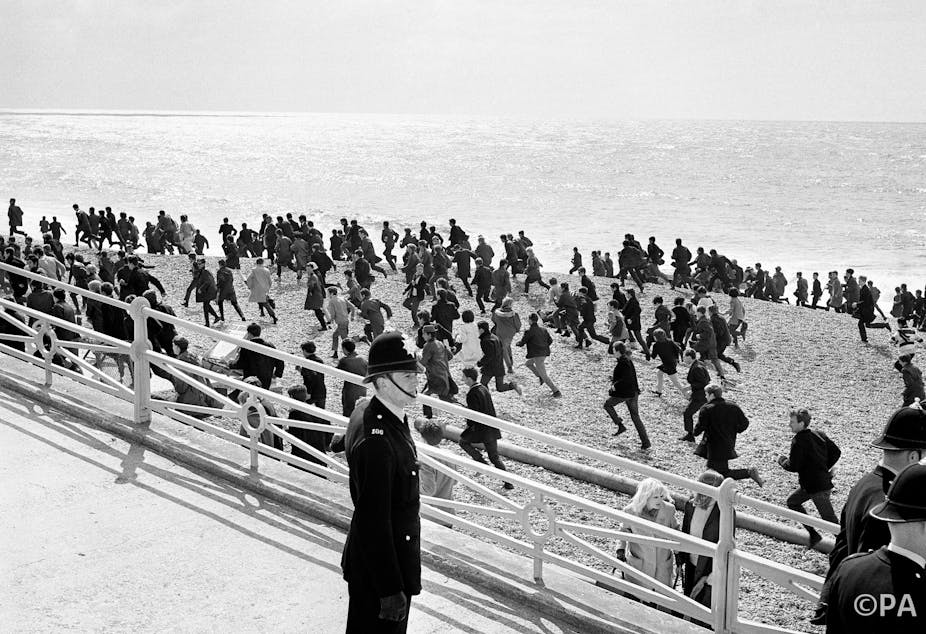It’s 50 years since Mods and Rockers rumbled by the sea in Margate, Broadstairs and Brighton; since their images were captured for posterity in iconic black and white photos of deck chairs being thrown on to rocky beaches.
And coincidentally, it’s also been 35 years since director Franc Roddam’s cult film, based on the Who’s 1973 album Quadrophenia, mythologised that weekend further.
Walk through the streets of the city and you’ll find you are never far from the Mods’ trademark target symbol. There are Quadrophenia walking tours of Brighton; you can even visit the alleyway where Jimmy and Steph have it off, and the sites near the pier where the trouble began. The “Battle of Brighton” is very much a cultural crisis that we love to relive.
But it’s a bit odd to look back fondly toward a grey, violent, Whitsun weekend in the early ‘60s, odd that there’s enduring nostalgia for the moment. In the early 1970s the sociologist Stanley Cohen showed the ways in which, even as they were vilified by the press, Mods and Rockers were adopted as spectacle, a kind of seaside attraction. After the initial reporting people began planning their weekends so as to watch the clashes.
The press also exaggerated the violence, which was less extreme than portrayed here in the Daily Express May 19, 1964:
There was Dad asleep in a deckchair and Mum making sandcastles with the children when the 1964 boys took over the beaches at Margate and Brighton yesterday and smeared the traditional postcard scene with blood and violence.
Smeared blood on the beaches was hardly the order of the day. In reality the typical charge (for the 76 arrested in Brighton) was obstructing the police or the use of threatening behaviour.

The nature of these arrests interests me: did the Mods and Rockers take to the beaches primarily to fight each other, or to get up the noses of the powers that be? Our image of Mods and Rockers travelling on bikes and scooters from London, explicitly to do battle with each other, is potentially misleading; it was during weekends like this one that the differences between the two groups hardened. Before then, they were frustrated young people in local gangs, looking for some thrills. But in the aftermath of the clashes, Mods and Rockers’ identities became primarily defined by their contrast to each other.
But for me, and for many, it is the Mods that have an enduring and nostalgic pull. In the crowd scenes of Quadrophenia the triumphant communal cry of “We are, we are, we are the mods!” is both menacing and exhilarating, eliciting a certain jealousy for such a strong sense of group identity. That chant appealed to me as a middle-class American suburban teen, whose image of the Mods came entirely through an obsession with both the album and the film. I was desperate for that kind of enabling gang, both to hide in, and to assert my shaky teenage individuality. As Jimmy says in the film: “I don’t want to be the same as everyone else. That’s why I’m a mod, see?”
And of course there’s the look. The sharper image of the Mods, compared to the rough and ready leather-clad Rockers, might also help account for the way they’ve lived on in cultural memory. The Rockers’ look was familiar from American motorcycle films like The Wild One (1953).
Mods were something else entirely; working-class teenagers, with a strong sense of upper-class style, they invented a modern youth subculture. Mods exuded cool: never has youth rebellion dressed or danced so well. “Clean living under difficult circumstances”, was how the uber-Mod Pete Meaden famously defined it.
Mods trafficked in European savoir-faire. Turning their back in the early ‘60s on post-war austerity, the Mods eschewed English cultural isolationism for a more expansive (and expensive) cosmopolitan future which included all-night Soho espresso bars and Italian tailoring, set to a soundtrack of American jazz and soul music. Mods were stealth weapons; their impeccable suits let them blend into an office setting. They didn’t initially appear dangerous.

Punks in the 1970s dressed to offend; you could see a Mohawk coming a mile away. By contrast Mods were chameleon-like anarchists, who dressed better than their bosses, boring away at society from the inside. The class contradictions around the Mod image are some of the most interesting paradoxes to explore; there were clearly middle-class fears activated by the idea of working-class youth having the money to dress the way they did.
I’ve tried to debunk some myths about the Mods and those violent weekends 50 years ago, but this is also inevitably touched by my own romanticising. The Mod ethos may have always been a myth, an aspiration, rather than an easily lived reality. The album Quadrophenia focuses on the troubled, pilled-up, Jimmy, who is plagued by his inability to live up to the Mod image:
How come the other tickets look much better?
Without a penny to spend, they dress to the letter.
Taken together, the Who’s album and Roddam’s film brilliantly explore the perils of youth and alienation at that early 1960s moment.
And this gap between image and reality, this pull, this nostalgia, is particularly interesting to think about today. It’s been argued recently that resistant youth subcultural identity is disappearing in the era of rapid fire youth consumption and online identities. Parents dress like their teenage kids, listen to the same bands, and devour The Hunger Games and Playstation games. And adolescents facing a precarious economic future are forced to grow up fast.
I’m not sure what versions of youth rebellion and identity are possible now, in an era when the distinctions between adult and adolescent have become so tenuous. And perhaps this is why the lure of the Mod is still so strong.

